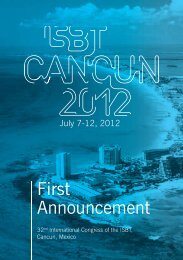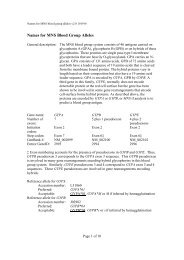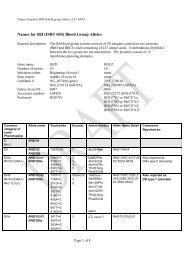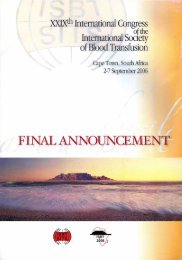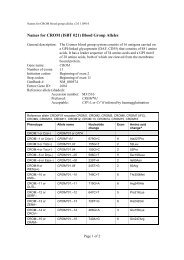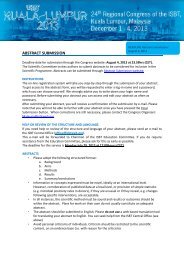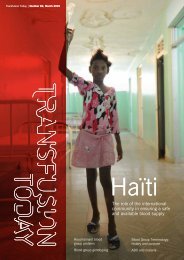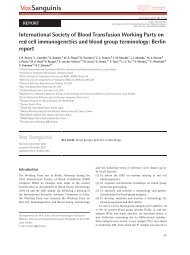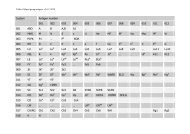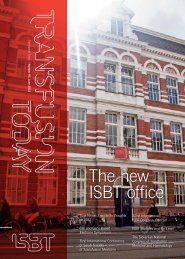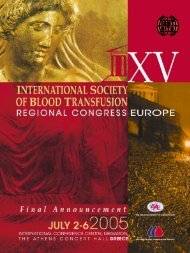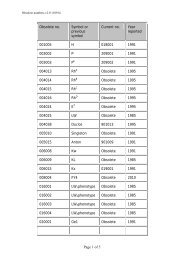Berlin 2010 - International Society of Blood Transfusion
Berlin 2010 - International Society of Blood Transfusion
Berlin 2010 - International Society of Blood Transfusion
Create successful ePaper yourself
Turn your PDF publications into a flip-book with our unique Google optimized e-Paper software.
REPORT<br />
Vox Sanguinis (2011)<br />
ª 2011 The Author(s)<br />
Vox Sanguinis ª 2011 <strong>International</strong> <strong>Society</strong> <strong>of</strong> <strong>Blood</strong> <strong>Transfusion</strong><br />
DOI: 10.1111/j.1423-0410.<strong>2010</strong>.01462.x<br />
<strong>International</strong> <strong>Society</strong> <strong>of</strong> <strong>Blood</strong> <strong>Transfusion</strong> Working Party on<br />
red cell immunogenetics and blood group terminology: <strong>Berlin</strong><br />
report<br />
J. R. Storry, 1 L. Castilho, 2 G. Daniels, 3 W. A. Flegel, 4 G. Garratty, 5 C. L. Francis, 6 J. M. Moulds, 7 J. J. Moulds, 7 M. L. Olsson, 8<br />
J. Poole, 3 M. E. Reid, 6 P. Rouger, 9 E. van der Schoot, 10 M. Scott, 3 E. Smart, 11 Y. Tani, 12 L.-C. Yu, 13 S. Wendel, 14 C. Westh<strong>of</strong>f, 6<br />
V. Yahalom 15 & T. Zelinski 16<br />
1 Clinical Immunology and <strong>Transfusion</strong> Medicine, University and Regional Laboratories, Lund, Sweden<br />
2 University <strong>of</strong> Campinas ⁄ Hemocentro, Campinas, Brazil<br />
3 Bristol Institute for <strong>Transfusion</strong> Sciences and IBGRL, NHSBT, Bristol, UK<br />
4 NIH Clinical Center, Department <strong>of</strong> <strong>Transfusion</strong> Medicine, Bethesda, MD, USA<br />
5 American Red Cross <strong>Blood</strong> Services, Pomona, CA, USA<br />
6 New York <strong>Blood</strong> Center, New York, NY, USA<br />
7 LifeShare <strong>Blood</strong> Centers, Shreveport, LA, USA<br />
8 Department <strong>of</strong> Laboratory Medicine, Division <strong>of</strong> Haematology and <strong>Transfusion</strong> Medicine, Lund University, Lund, Sweden<br />
9 Centre National de Référence pour les Groupes sanguines, Paris, France<br />
10 Sanquin Research at CLB, Amsterdam, The Netherlands<br />
11 Durban, South Africa<br />
12 Osaka Red Cross <strong>Blood</strong> Center, Osaka, Japan<br />
13 Mackay Memorial Hospital and National Taiwan University, Taipei, Taiwan<br />
14 <strong>Blood</strong> Bank, Hospital Sirio-Libanes, São Paulo, Brazil<br />
15 NBGRL Magen David Adom, Ramat Gan, Israel<br />
16 Rh Laboratory, Winnipeg, MB, Canada<br />
Key words: blood groups, genetics, terminology.<br />
Received: 8 December <strong>2010</strong>,<br />
accepted 9 December <strong>2010</strong><br />
Introduction<br />
The Working Party met in <strong>Berlin</strong>, Germany during the<br />
<strong>2010</strong> <strong>International</strong> <strong>Society</strong> <strong>of</strong> <strong>Blood</strong> <strong>Transfusion</strong> (ISBT)<br />
Congress. While no changes were made to the current<br />
classification as documented in <strong>Blood</strong> Group Terminology<br />
2004 [1] and the 2007 update [2], following a meeting <strong>of</strong><br />
the <strong>International</strong> Scientific Advisory Committee in Cairo,<br />
the Working Party was renamed the Working Party on<br />
Red Cell Immunogenetics and <strong>Blood</strong> Group Terminology<br />
Correspondence: Dr Jill R. Storry, Clinical Immunology & <strong>Transfusion</strong><br />
Medicine, University and Regional Laboratories, Klinikgatan 21, SE-22185<br />
Lund, Sweden<br />
E-mail: jill.storry@med.lu.se<br />
and the following terms <strong>of</strong> reference were drawn up by<br />
Dr Ge<strong>of</strong>f Daniels:<br />
(1) To advise the ISBT on matters relating to red cell<br />
immunogenetics.<br />
(2) To organize international workshops on blood group<br />
molecular genotyping.<br />
(3) To maintain and monitor a terminology and genetic<br />
classification for blood group antigens.<br />
(4) To develop, maintain and monitor a terminology for<br />
blood group genes and their alleles.<br />
A total <strong>of</strong> 14 new blood group antigens were added to 10<br />
<strong>of</strong> the 30 current blood group systems (Table 1), and one<br />
antigen (FY4) was made obsolete. As described below, a<br />
new Collection containing the six MNS-related carbohydrate<br />
antigens was created. A new antigen, PX2, was added<br />
to Collection 209, from which the P k antigen was moved to<br />
1
2 J. R. Storry et al.<br />
Antigen<br />
name<br />
Incidence<br />
Nucleotide<br />
change a Amino acid change Reference<br />
Table 1 New blood group antigens<br />
RH58 CELO High RHCE 697C>G Gln233Glu [7]<br />
RH59 CEAG High RHCE 254G>C Ala85Gly [8]<br />
LU22 LURC High 223C>T Arg75Cys & dependent on Arg77 [9]<br />
KEL35 KELP High 780G>T<br />
2024G>A<br />
Leu260Phe<br />
Arg675Gln<br />
DI22 DISK High 1694G>C Gly565Ala [12]<br />
DO7 DOMR High 431C>T Ala144Glu [13]<br />
432C>A<br />
CO4 Co4 High 140A>G Gln47Arg [14,15]<br />
GE10 GEPL High 134C>T GPC Pro45Leu; GPD Pro24Leu [16]<br />
GE11 GEAT High 56A>T Asp19Val [16]<br />
GE12 GETI High 80C>T GPC Thr27Ile; GPD Thr6Ile [16]<br />
CROM16 CROZ High 389G>A Arg130His [17]<br />
OK2 OKGV High 176G>T Gly59Val [18]<br />
OK3 OKVM High 178G>T Val60Met [19]<br />
JMH6 JMHQ High 1040G>T Arg347Leu [20]<br />
[11]<br />
a Numbers used for nucleotide and amino acid location are counted from A <strong>of</strong> the initiating methionine<br />
codon and that methionine residue, respectively.<br />
the P blood group system, and was renamed P1PK. This<br />
brings the current total <strong>of</strong> recognized blood group antigens<br />
to 328, <strong>of</strong> which 284 are contained within the 30 blood<br />
groups systems.<br />
System 3: P1PK<br />
It has recently been shown that a nucleotide polymorphism<br />
upstream <strong>of</strong> the coding region <strong>of</strong> the A4GALT gene, previously<br />
shown to encode the 4-a-galactosyltransferase that<br />
synthesizes the P k antigen [3–5], correlates with P1 antigen<br />
expression [6]. A novel short transcript <strong>of</strong> A4GALT<br />
revealed a new exon in intron 1, termed exon 2a. Three<br />
polymorphisms were identified in the exon, <strong>of</strong> which one<br />
nucleotide change correlates with the P 1 ⁄ P 2 phenotypes<br />
and for the first time, permits genotyping for P1 antigen<br />
expression [6]. This finding ties the P1 and P k antigens,<br />
long known to be related serologically and biochemically,<br />
to the same gene – A4GALT. Based on the molecular evidence<br />
(from > 200 donors) linking the two antigens, it was<br />
proposed to rename the P system to P1PK. This change was<br />
also based on the confusion that would arise if the P1 and<br />
P k antigens but not the P antigen belonged to a system still<br />
called P. The P1 antigen (now P1PK1) retains the ISBT<br />
number 003001, P k (P1PK2) becomes 003002, while number<br />
209002 (formerly P k ) is now obsolete.<br />
System 4: Rh<br />
Two high-incidence antigens have been added to the Rh<br />
system. RH58 (CELO) is antithetical to the low-incidence<br />
antigen, RH43 (Crawford), and is not encoded by RHCE*-<br />
ceCF (48C, 697G, 733G) and very weakly expressed on the<br />
Dc(e) phenotype encoded by RHCE*ceBP [7]. Two patients,<br />
one who was homozygous for RHC E*ceCF the other who<br />
had RHCE*ceCF in trans to a silenced RHCE*cE, had each<br />
made an anti-Rh17-like antibody that was shown to be<br />
anti-CELO. Furthermore, the amino acid changes encoded<br />
by RHCE*ceCF (Trp16Cys, Gln233Glu, Leu245Val) give rise<br />
to partial c and e antigens, which have permitted the production<br />
<strong>of</strong> alloanti-c and alloanti-e, respectively. CELO is<br />
also absent from Rh null ,D)), and DC W ) phenotype RBCs.<br />
RH59 (CEAG) is a high-incidence antigen associated with<br />
an allele encoding a partial e antigen [8]. It was identified<br />
following the investigation <strong>of</strong> three multiply transfused<br />
patients whose plasma contained alloanti-e but whose RBCs<br />
typed e+. The absence <strong>of</strong> CEAG is defined by the single<br />
nucleotide change RHCE*ce 254G>C that encodes an amino<br />
acid exchange <strong>of</strong> Ala85Gly.<br />
System 5: Lutheran<br />
A new high-incidence antigen, LU22 (LURC), has been<br />
added to the Lutheran system. The molecular change resulting<br />
in the LU:)22 phenotype was shown to be a nucleotide<br />
change in exon 3, 223C>T that changed Arg75Cys [9]. The<br />
RBCs <strong>of</strong> the proband phenotyped as Lu(a+b+ weak ), and<br />
sequencing revealed heterozygosity for this mutation carried<br />
on a LU*B allele and for an LU*A allele bearing a<br />
previously described Lu a -related polymorphism, 586G>A<br />
(Val196Ile) [10]. The Lu a ⁄ Lu b amino acid polymorphism<br />
occurs at residue 77, where Arg77 defines Lu b and His77<br />
Ó 2011 The Author(s)<br />
Vox Sanguinis Ó 2011 <strong>International</strong> <strong>Society</strong> <strong>of</strong> <strong>Blood</strong> <strong>Transfusion</strong>, Vox Sanguinis (2011)
Red cell immunogenetics and blood group terminology 3<br />
defines Lu a . The proximity <strong>of</strong> Arg75Cys presumably interrupts<br />
and weakens the expression <strong>of</strong> the Lu b antigen<br />
encoded by this allele. Furthermore, the occurrence <strong>of</strong> the<br />
LURC-negative phenotype on a heterozygous LU*A ⁄ LU*B<br />
background demonstrates the reliance <strong>of</strong> LURC on the Lu b<br />
antigen residue, Arg77 for expression.<br />
System 6: Kell<br />
Another high-incidence antigen was added to the Kell system:<br />
KEL35 (KELP), defined by an antibody that was nonreactive<br />
only with K 0 RBCs and those <strong>of</strong> the antibody maker<br />
[11]. The patient’s RBCs typed KEL:)1,2–3,4,6,11,)12,22,<br />
although sequence analysis did not confirm the K:)12<br />
phenotype. However, the proband was homozygous for<br />
two novel mutations: 780G>T in exon 8, which encodes<br />
Leu260Phe, and 2024G>A in exon 18, encoding Arg<br />
675Gln. Leu260Phe is located on the Kell glycoprotein at a<br />
position distal from the membrane and modelling predicts<br />
a change in the molecular surface <strong>of</strong> Kell. However, amino<br />
acid position 675 lies close to or in the membrane. Both<br />
mutations are seemingly unconnected with Arg548 that<br />
defines K12 and the effect <strong>of</strong> these two novel mutations on<br />
K12 expression remains unresolved.<br />
System 8: Duffy<br />
Following the criteria that an antibody to a blood group<br />
antigen must be extant for that antigen to be recognized,<br />
and based on only scant original evidence for its existence,<br />
FY4 has been made obsolete.<br />
System 10: Diego<br />
A high-incidence antigen antithetical to DI9 (Wu) has been<br />
identified. The new antigen, DI22 (DISK), was characterized<br />
by an apparently naturally occurring, strongly agglutinating<br />
antibody reactive both at 18 and 37°C and by the indirect<br />
antiglobulin test [12]. DISK was shown to be sensitive to<br />
a-chymotrypsin treatment, but resistant to other commonly<br />
used proteases. Targeted sequence analysis <strong>of</strong> SLC4A1 exon<br />
14 revealed homozygosity in the proband and heterozygosity<br />
in a sample from her brother, for the mutation 1694G>C<br />
that encodes Gly565Ala. The RBCs <strong>of</strong> her brother reacted<br />
more weakly with her antibody, suggesting that the anti-<br />
DISK exhibits dosage in DI:9,22 individuals.<br />
System 14: Dombrock<br />
DO7 (DOMR) is defined by an antibody to a high-incidence<br />
antigen produced in a patient, homozygous for two adjacent<br />
nucleotide changes 431C>A, 432C>A that encode a<br />
change <strong>of</strong> Ala144Glu [13]. These changes are present with a<br />
DO*B-WL allele (DO*793G, DO*323G, DO*350C, DO*547T,<br />
DO*898G). The DO*B-WL allele is predicted to encode the<br />
phenotype Do(a)b+), Hy+, Jo(a+), DOYA+, however, the<br />
patient’s RBCs typed Do(a)b+), Hy+ w , Jo(a+ w ), DOYA+ w .<br />
Her RBCs also typed Gy(a)) with a polyclonal antibody but<br />
were reactive with several monoclonal antibodies to the<br />
Dombrock glycoprotein. Further complexity was demonstrated<br />
by the plasma antibody that was nonreactive or<br />
only very weakly reactive with six Hy) samples, nonreactive<br />
with Gy(a)) RBCs but reactive with Jo(a)) and DOYA)<br />
RBCs.<br />
System 15: CO<br />
An antibody compatible with Co(a)b)) RBCs but weakly<br />
incompatible with Co(a)b+) RBCs was identified in the<br />
plasma <strong>of</strong> a patient whose RBCs typed Co(a)b)) [14].<br />
Molecular analysis <strong>of</strong> AQP1 revealed homozygosity for<br />
140A>G, encoding the amino acid change Gln47Arg, in<br />
close proximity to the Co a ⁄ Co b polymorphism at residue<br />
45. Samples from a second Co(a)b)) proband homozygous<br />
for the same 140A>G mutation were investigated following<br />
detection <strong>of</strong> an antibody to a high-incidence antigen initially<br />
identified as anti-Co3 [15]. Unexpectedly, her RBCs<br />
were shown to have functional aquaporin 1. Expression<br />
studies with AQP1 encoding Arg47 demonstrated a loss <strong>of</strong><br />
Co a antigen expression despite the presence <strong>of</strong> the Co a -<br />
specific Ala45, consistent with the observed phenotype.<br />
Arnaud et al. [15] also re-evaluated three antisera classified<br />
as anti-Co3 in their collection and re-identified one <strong>of</strong> the<br />
three sera as anti-Co4. PCR–RFLP analysis revealed that<br />
this sample also was homozygous for AQP1 140G. Thus,<br />
this polymorphism defines a new high-incidence antigen,<br />
CO4, in the Colton blood group system.<br />
System 20: Gerbich<br />
Three novel high-incidence antigens among four individuals<br />
have been added to the Gerbich blood group system:<br />
GE10 (GEPL), GE11 (GEAT), GE12 (GETI) [16]. GE10 was<br />
identified following the investigation <strong>of</strong> an individual<br />
whose RBCs typed GE:2,3,4 but whose plasma contained an<br />
apparent alloanti-Ge3. Immunoblotting analysis showed<br />
the presence <strong>of</strong> both normal GPC ⁄ GPD and two unexpected<br />
bands that were approximately 2 kDa smaller than normal.<br />
DNA sequence analysis revealed a single point mutation in<br />
GYPC, 134C>T, which encodes an amino acid change Pro<br />
to Leu at positions 45 and 24 <strong>of</strong> GPC and GPD, respectively.<br />
Anti-Ge11 was nonreactive with GE:)2,)3 and<br />
GE:)2,)3,)4 RBCs, but demonstrated variable reactivity<br />
with GE:)2,3 RBCs. Bands corresponding to GPC and GPD<br />
<strong>of</strong> apparently normal mass were shown by immunoblotting<br />
and DNA sequence analysis revealed homozygosity for a<br />
Ó 2011 The Author(s)<br />
Vox Sanguinis Ó 2011 <strong>International</strong> <strong>Society</strong> <strong>of</strong> <strong>Blood</strong> <strong>Transfusion</strong>, Vox Sanguinis (2011)
4 J. R. Storry et al.<br />
point mutation 56A>T that encodes an amino acid change<br />
<strong>of</strong> Asp19Val in GPC.<br />
Anti-Ge12 was identified in the plasma <strong>of</strong> two siblings<br />
and an unrelated individual whose RBCs typed GE:)2,3,4<br />
(although typing for Ge3 and Ge4 on the siblings’ RBCs was<br />
weaker than controls). Immunoblotting analysis <strong>of</strong> RBC<br />
membranes from the siblings revealed normal GPC and<br />
GPD as well as a broad band similar to that seen in<br />
GE:)2,3,4 RBCs, although the RBCs <strong>of</strong> the unrelated patient<br />
were normal. DNA sequence analysis revealed that the siblings<br />
showed compound heterozygosity for two mutations:<br />
80C>T in exon 2 that encodes Thr27Ile in GPC and Thr6Ile<br />
in GPD and a transition in the invariant exon-adjacent<br />
nucleotide <strong>of</strong> intron 1, IVS2 )1g>a. This change most likely<br />
causes exon skipping and results in an aberrant protein,<br />
similar to GE:)2,3,4 RBCs in which exon 2 is deleted and<br />
explains the unusual blotting results. The unrelated patient<br />
was homozygous for 80C>T. Thus, Thr27Ile and Thr6Ile<br />
define the GE12 (GETI) antigen.<br />
System 21: Cromer<br />
An antibody directed at an apparently Cromer-related<br />
high-incidence antigen was shown to detect a new antigen<br />
in that system, CROM16 (CROZ) [17]. DNA sequence analysis<br />
<strong>of</strong> DAF revealed a missense transition, 389G>A in exon<br />
3 that encodes an amino acid change <strong>of</strong> Arg130His.<br />
System 24: OK<br />
Two new high-incidence antigens have been identified in the<br />
OK blood group system; OK2 (OKGV) and OK3 (OKVM). The<br />
OK:)2 phenotype described in 2003 was shown to arise from<br />
a nucleotide substitution in exon 2 <strong>of</strong> the basigin gene, BSG<br />
176G>T, which encodes the amino acid change Gly59Val<br />
[18]. This mutation was found only in the proposita, together<br />
with two additional silent single nucleotide exchanges;<br />
195C>T (Asp65) and 234G>C (Ser78). Interestingly, an additional<br />
silent transition, 327T>C (Ala108), was identified in<br />
one <strong>of</strong> the control samples sequenced in this study.<br />
Karamatic Crew et al. [19] also determined the molecular<br />
basis <strong>of</strong> the OK:)3 phenotype: the proband’s plasma was<br />
nonreactive with three examples <strong>of</strong> Ok(a)) RBCs tested,<br />
although her RBCs typed Ok(a+). Sequence analysis <strong>of</strong> BSG<br />
revealed homozygosity for another mutation in exon 2:<br />
178G>A, causing a Val60Met change in the OK glycoprotein<br />
(basigin, CD147).<br />
System 26: JMH<br />
A sixth antigen has been added to the increasingly polymorphic<br />
JMH blood group system; JMH6 (JMHQ). An antibody<br />
with JMH-related specificity in the plasma <strong>of</strong> four<br />
unrelated native Americans led to the investigation <strong>of</strong><br />
SEMA7A [20]. The molecular basis was identified as a<br />
transversion, 1040G>T, which encodes a change <strong>of</strong><br />
Arg347Leu. Recombinant forms <strong>of</strong> SEMA7A were constructed<br />
and used in an ELISA, which confirmed reactivity<br />
<strong>of</strong> the antibodies with wild-type SEMA7A, while the<br />
JMHQ) is<strong>of</strong>orm was nonreactive with the plasma samples.<br />
Collection 209: GLOB<br />
A new antigen, PX2 has been added to the GLOB Collection<br />
(209). This antigen is a high-incidence antigen defined by a<br />
terminal b3-N-acetylgalactosamine (b3GalNAc) on paragloboside<br />
and is known to be abundant on PP1P k ) (p phenotype)<br />
RBCs [21, 22]. Recent data have revealed that<br />
rare individuals lacking the P antigen make antibodies<br />
not only against globoside but also against this ‘new’<br />
antigen, which makes their plasma incompatible with p<br />
phenotype RBCs (J. R. Storry, T. Peyrard, A. H. Hult,<br />
Å. Hellberg, M. L. Olsson, manuscript in preparation).<br />
Collection 213<br />
A new Collection, number 213 (Table 2), has been created<br />
to recognize the carbohydrate antigens associated with the<br />
M and N antigens in MNS (ISBT system 002). These<br />
antigens have previously been defined biochemically as<br />
different substitutions <strong>of</strong> the sialic acid-carrying oligosaccharides<br />
on glycophorin A [23].<br />
Allele terminology<br />
To address the fourth term <strong>of</strong> reference listed at the beginning<br />
<strong>of</strong> this article, a subcommittee has drafted guidelines<br />
for blood group allele terminology that can be found on the<br />
<strong>Blood</strong> Group Terminology website at http://ibgrl.blood.<br />
co.uk/ISBTPages/ISBTHome.htm. Proposed allele terminology<br />
for 26 <strong>of</strong> the 30 blood group systems can also be found<br />
here and comments ⁄ feedback are encouraged. The proposed<br />
guidelines are intentionally noninclusive <strong>of</strong> silent<br />
single nucleotide polymorphisms (SNPs) and other<br />
Table 2 Collection 213: Antigens that are associated with M and N<br />
antigens and that are the result <strong>of</strong> different substitutions <strong>of</strong> the sialic<br />
acid-carrying oligosaccharides on glycophorin A [23]<br />
Number<br />
213001 Hu<br />
213002 M 1<br />
213003 Tm<br />
213004 Can<br />
213005 Sext<br />
213006 Sj<br />
Antigen name<br />
Ó 2011 The Author(s)<br />
Vox Sanguinis Ó 2011 <strong>International</strong> <strong>Society</strong> <strong>of</strong> <strong>Blood</strong> <strong>Transfusion</strong>, Vox Sanguinis (2011)
Red cell immunogenetics and blood group terminology 5<br />
polymorphisms that do not affect the protein product. The<br />
primary goal is to establish an allele name for use by transfusion<br />
medicine practitioners that is readily recognizable.<br />
Significantly, the recommendations state that an allele<br />
encoding an antigen can be named even when only a small<br />
region <strong>of</strong> the gene had been sequenced or analysed by a<br />
SNP-specific method. This criterion was based on current<br />
laboratory tests, both in-house and commercial assays,<br />
which generally focus only, or mainly, on the molecular<br />
polymorphism(s) that gives rise to the antigen. The intent is<br />
to make the terminology acceptable for use in laboratory<br />
reports <strong>of</strong> analysis, other correspondence and in publications<br />
relating to transfusion medicine. All comments should<br />
be sent to the Working Party chair at the address listed in<br />
Appendix 1. Tables giving the allele names will eventually<br />
reside on the ISBT website and not at the IBGRL website. At<br />
the time <strong>of</strong> submission, the address was not available, but it<br />
will be posted at the web address given above. Comments<br />
on the proposed nomenclature are welcomed before the<br />
next meeting <strong>of</strong> the Working Party in Mexico City, 2012.<br />
Acknowledgements<br />
Ann Fletcher, Marijke Overbeeke and Pertti Sistonen retired<br />
from the Working Party. We thank them for their helpful<br />
long-term contributions.<br />
References<br />
1 Daniels GL, Fletcher A, Garratty G,<br />
et al.: <strong>Blood</strong> group terminology 2004:<br />
from the <strong>International</strong> <strong>Society</strong> <strong>of</strong> <strong>Blood</strong><br />
<strong>Transfusion</strong> committee on terminology<br />
for red cell surface antigens. Vox Sang<br />
2004; 87:304–316<br />
2 Daniels G, Flegel WA, Fletcher A, et al.:<br />
<strong>International</strong> <strong>Society</strong> <strong>of</strong> <strong>Blood</strong> <strong>Transfusion</strong><br />
Committee on Terminology for Red<br />
Cell Surface Antigens: Cape Town<br />
report. Vox Sang 2007; 92:250–253<br />
3 Steffensen R, Carlier K, Wiels J, et al.:<br />
Cloning and expression <strong>of</strong> the histoblood<br />
group Pk UDP-galactose:<br />
Gal-beta1-4Glc-beta1-Cer alpha1,4-<br />
galactosyltransferase. Molecular genetic<br />
basis <strong>of</strong> the p phenotype. J Biol Chem<br />
2000; 275:16723–16729<br />
4 Keusch JJ, Manzella SM, Nyame KA,<br />
et al.: Cloning <strong>of</strong> Gb3 synthase, the<br />
key enzyme in globo-series glycosphingolipid<br />
synthesis, predicts a family<br />
<strong>of</strong> alpha 1, 4-glycosyltransferases<br />
conserved in plants, insects, and mammals.<br />
J Biol Chem 2000; 275:25315–<br />
25321<br />
5 Furukawa K, Iwamura K, Uchikawa M,<br />
et al.: Molecular basis for the p phenotype.<br />
Identification <strong>of</strong> distinct and<br />
multiple mutations in the alpha1,4-<br />
galactosyltransferase gene in Swedish<br />
and Japanese individuals. J Biol Chem<br />
2000; 275:37752–37756<br />
6 Thuresson B, Westman JS, Olsson ML:<br />
Identification <strong>of</strong> a novel A4GALT exon<br />
reveals the genetic basis <strong>of</strong> the P1 ⁄ P2<br />
histo-blood groups. <strong>Blood</strong> <strong>2010</strong>; doi:<br />
10.1182/blood-<strong>2010</strong>-08-301333<br />
7 Hipsky CH, Lomas-Francis C, Fuchisawa<br />
A, et al.: RHCE*ceCF encodes partial c<br />
and partial e but not CELO, an antigen<br />
antithetical to Crawford. <strong>Transfusion</strong><br />
<strong>2010</strong>; doi: 10.1111/j.1537-2995.<strong>2010</strong>.<br />
02764.x<br />
8 Vege S, Nickle PA, Shirey RS, et al.: A<br />
novel 254G>C (Ala85Gly) change associated<br />
with partial Rhe and alloanti-e.<br />
<strong>Transfusion</strong> 2009; 49(Suppl):15A<br />
9 Karamatic Crew V, Thornton N, Burton<br />
NM, et al.: Two heterozygous mutations<br />
in an individual result in the loss <strong>of</strong> a<br />
novel high incidence Lutheran antigen.<br />
Transfus Med 2009; 19(Suppl 1):10<br />
10 Gowland P, Hustinx H, Niederhauser B,<br />
et al.: A new polymorphism within the<br />
Lua ⁄ Lub blood group. Transfus Med<br />
Hemother 2009; 32(Suppl):54–55<br />
11 Karamatic Crew V, Poole J, Bullock T,<br />
et al.: KELP (KEL35): a new high incidence<br />
antigen in the Kell blood group<br />
system defined by two homozygous<br />
missense mutations in KEL. Transfus<br />
Med <strong>2010</strong>; 20(Suppl 1):30<br />
12 Poole J, Thornton NM, Tilley L, et al.:<br />
Novel high incidence antigen in the<br />
Diego blood group system (DISK) and<br />
clinical significance <strong>of</strong> anti-DISK. Vox<br />
Sang <strong>2010</strong>; 99(Suppl 1):54–55<br />
13 Costa FP, Hue-Roye K, Sausais L, et al.:<br />
Absence <strong>of</strong> DOMR, a new antigen in the<br />
Dombrock blood group system that<br />
weakens expression <strong>of</strong> Do, Gy, Hy, Jo,<br />
and DOYA antigens. <strong>Transfusion</strong> <strong>2010</strong>;<br />
50:2026–2031<br />
14 Wagner FF, Flegel WA: A clinically relevant<br />
Co(a)-like allele encoded by AQP1<br />
(Q47)R. <strong>Transfusion</strong> 2002; 42:24S–25S<br />
15 Arnaud L, Helias V, Menanteau C, et al.:<br />
A functional AQP1 allele producing a<br />
Co(a-b-) phenotype revises and extends<br />
the Colton blood group system. <strong>Transfusion</strong><br />
<strong>2010</strong>; 50:2106–2116<br />
16 Poole J, Tilley L, Hudler P, et al.: Novel<br />
mutations in GYPC giving rise to lack <strong>of</strong><br />
Ge epitopes and anti-Ge production.<br />
Vox Sang 2008; 95:180–181<br />
17 Karamatic Crew V, Poole J, Thornton N,<br />
et al.: Two unusual cases within the<br />
Cromer blood group system: I)a novel<br />
high incidence antigen Croz and II)a<br />
novel molecular basis <strong>of</strong> Inab phenotype.<br />
Transfus Med <strong>2010</strong>; 20(Suppl<br />
1):12<br />
18 Karamatic Crew V, Daniels G, Poole J: A<br />
new variant in the Ok blood group<br />
system. Transfus Med 2003; 13(Suppl<br />
1):32<br />
19 Karamatic Crew V, Thomas R, Gillen B,<br />
et al.: A novel variant in the Ok blood<br />
group system. Transfus Med 2006;<br />
16(Suppl 1):41<br />
20 Richard M, St Laurent J, Perreault J, et<br />
al.: A new SEMA7A variant found in<br />
Native Americans with alloantibody.<br />
Vox Sang <strong>2010</strong>; doi: 10.1111/j.1423-<br />
0410.<strong>2010</strong>.01413.x<br />
21 Kannagi R, Fukuda MN, Hakomori S: A<br />
new glycolipid antigen isolated from<br />
human erythrocyte membranes reacting<br />
with antibodies directed to globo-<br />
N-tetraosylceramide (globoside). J Biol<br />
Chem 1982; 257:4438–4442<br />
22 Thorn JJ, Levery SB, Salyan ME, et al.:<br />
Structural characterization <strong>of</strong> x2 glycosphingolipid,<br />
its extended form, and<br />
its sialosyl derivatives: accumulation<br />
associated with the rare blood group p<br />
phenotype. Biochemistry 1992; 31:<br />
6509–6517<br />
23 Dahr W, Knuppertz G, Beyreuther K, et<br />
al.: Studies on the structures <strong>of</strong> the Tm,<br />
Sj, M1, Can, Sext and Hu blood group<br />
antigens. Biol Chem Hoppe Seyler 1991;<br />
372:573–584<br />
Ó 2011 The Author(s)<br />
Vox Sanguinis Ó 2011 <strong>International</strong> <strong>Society</strong> <strong>of</strong> <strong>Blood</strong> <strong>Transfusion</strong>, Vox Sanguinis (2011)
6 J. R. Storry et al.<br />
Appendix 1. Members <strong>of</strong> the Working Party<br />
Dr JR Storry (Current chair): Department <strong>of</strong> Clinical Immunology<br />
and <strong>Transfusion</strong> Medicine, University and Regional<br />
Laboratories, Lund, Sweden (jill.storry@med.lu.se).<br />
Dr GL Daniels (Immediate Past Chair): Bristol Institute<br />
for <strong>Transfusion</strong> Sciences, NHS <strong>Blood</strong> and Transplant,<br />
Filton, UK (ge<strong>of</strong>f.daniels@nhsbt.nhs.uk).<br />
Pr<strong>of</strong> Dr L. Castilho: University <strong>of</strong> Campinas ⁄ Hemocentro,<br />
Campinas, Brazil (castilho@unicamp.br).<br />
Pr<strong>of</strong> Dr WA Flegel: Department <strong>of</strong> <strong>Transfusion</strong> Medicine,<br />
Clinical Center, National Institutes <strong>of</strong> Health, Bethesda, MD,<br />
USA (bill.flegel@cc.nih.gov).<br />
Pr<strong>of</strong> Dr G Garratty: American Red Cross <strong>Blood</strong> Services,<br />
Southern California Region, Pomona, CA, USA (garratty@<br />
usa.redcross.org).<br />
Ms C Lomas-Francis: New York <strong>Blood</strong> Center, New York,<br />
NY, USA (clomas-francis@nybloodcenter.org).<br />
Mr JJ Moulds: LifeShare <strong>Blood</strong> Centers, Shreveport, LA,<br />
USA (jjmoulds@lifeshare.org).<br />
Dr JM Moulds: LifeShare <strong>Blood</strong> Centers, Shreveport, LA,<br />
USA (jmmoulds@lifeshare.org).<br />
Pr<strong>of</strong> Dr ML Olsson: Department <strong>of</strong> Laboratory Medicine,<br />
Division <strong>of</strong> Hematology and <strong>Transfusion</strong> Medicine, Lund<br />
University, Lund, Sweden (martin_l.olsson@med.lu.se).<br />
Ms J Poole: IBGRL, NHS <strong>Blood</strong> and Transplant, Bristol,<br />
UK (joyce.poole@nhsbt.nhs.uk).<br />
Dr ME Reid: New York <strong>Blood</strong> Center, New York, NY, USA<br />
(mreid@nybloodcenter.org).<br />
Pr<strong>of</strong> Dr Ph Rouger: Centre national de Référence pour les<br />
Groupes sanguines, Paris, France (prouger@ints.fr).<br />
Pr<strong>of</strong> Dr CE van der Schoot: Sanquin Research at CLB,<br />
Amsterdam, The Netherlands (e.vanderschoot@sanquin.nl).<br />
Pr<strong>of</strong> Dr M Scott: Bristol Institute for <strong>Transfusion</strong><br />
Sciences, NHS <strong>Blood</strong> and Transplant, Filton, Bristol, UK<br />
(marion.scott@nhsbt.nhs.uk).<br />
Mrs E Smart: Durban, South Africa (eapsmart@svnet.<br />
co.za).<br />
Dr Y Tani: Osaka Red Cross <strong>Blood</strong> Center, Osaka, Japan<br />
(tani@osaka.bc.jrc.or.jp).<br />
Dr LC Yu: Mackay Memorial Hospital and National<br />
Taiwan University, Taipei, Taiwan (yulc@ntu.edu.tw).<br />
Dr S Wendel: <strong>Blood</strong> Bank, Hospital Sirio-Libanes, São<br />
Paulo, Brazil (snwendel@terra.com.br).<br />
Dr CM Westh<strong>of</strong>f: American Red Cross and the University<br />
<strong>of</strong> Pennsylvania, Philadelphia, PA, USA., and now<br />
New York <strong>Blood</strong> Center, New York, NY (cwesth<strong>of</strong>f@<br />
nybloodcenter.org).<br />
Dr V Yahalom: NBGRL Magen David Adom, Ramat Gan,<br />
Israel (veredy@mda.org.il).<br />
Dr T Zelinski: Rh Laboratory, Winnipeg, Manitoba,<br />
Canada (zelinski@ms.umanitoba.ca).<br />
Newly appointed members<br />
Dr M de Haas: Sanquin <strong>Blood</strong> Supply Foundation, Amsterdam,<br />
The Netherlands (m.dehaas@sanquin.nl).<br />
Dr KM Hyland: Australian Red Cross <strong>Blood</strong> Services,<br />
Brisbane, Australia (chyland@arcbs.redcross.org.au).<br />
Dr N Nogues: Banc de Sang i Teixits, Barcelona, Spain<br />
(nnogues@bstcat.net).<br />
Ó 2011 The Author(s)<br />
Vox Sanguinis Ó 2011 <strong>International</strong> <strong>Society</strong> <strong>of</strong> <strong>Blood</strong> <strong>Transfusion</strong>, Vox Sanguinis (2011)



